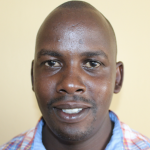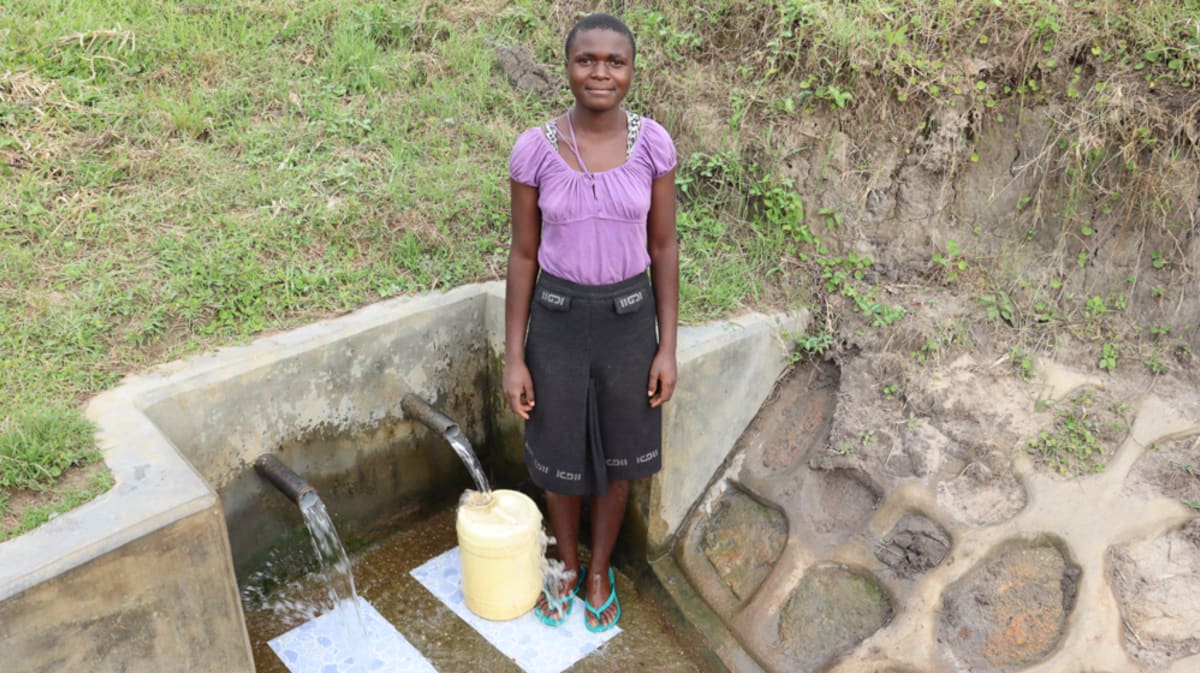May, 2020: COVID-19 Prevention Training Update at Shihingo Community, Mangweli Spring
Our teams are working on the frontlines of the COVID-19 pandemic. Join us in our fight against the virus while maintaining access to clean, reliable water.

All eyes on the trainer in the mask
We are carrying out awareness and prevention trainings on the virus in every community we serve. Very often, our teams are the first (and only) to bring news and information of the virus to rural communities like Shihingo, Kenya.
We trained more than 10 people on the symptoms, transmission routes, and prevention of COVID-19. Due to public gathering concerns, we worked with trusted community leaders to gather a select group of community members who would then relay the information learned to the rest of their family and friends.

Trainer Christine leads handwashing demonstration
We covered essential hygiene lessons:
- Demonstrations on how to build a simple handwashing station
- Proper handwashing technique
- The importance of using soap and clean water for handwashing
- Cleaning and disinfecting commonly touched surfaces including at the water point.

Handwashing demonstration
We covered COVID-19-specific guidance in line with national and international standards:
- Information on the symptoms and transmission routes of COVID-19
- What social distancing is and how to practice it
- How to cough into an elbow
- Alternative ways to greet people without handshakes, fist bumps, etc.
- How to make and properly wear a facemask.

Handwashing demonstration
During training, we installed a new handwashing station with soap near the community’s water point, along with a sign with reminders of what we covered.

Trainers review the prevention reminders chart
Due to the rampant spread of misinformation about COVID-19, we also dedicated time to a question and answer session to help debunk rumors about the disease and provide extra information where needed.

Chart installed at the spring
We continue to stay in touch with this community as the pandemic progresses. We want to ensure their water point remains functional and their community stays informed about the virus.

An elder reads the informational pamphlet on COVID-19
Water access, sanitation, and hygiene are at the crux of disease prevention. You can directly support our work on the frontlines of COVID-19 prevention in all of the communities we serve while maintaining their access to safe, clean, and reliable water.

June, 2019: Shihingo Community, Mangweli Spring Project Complete!
Shihingo Community now has clean water! Mangweli Spring has been transformed into a flowing source of clean water thanks to your donation. The spring is protected from contamination, five sanitation platforms have been provided for the community, and training has been done on sanitation and hygiene.
Spring Protection
Community members provided all locally available construction materials, e.g bricks, wheelbarrows of clean sand, wheelbarrows of ballast, fencing poles and gravel. Accommodations and meals were provided for the artisan, too.

Community member tosses a brick to the artisan.
The Process
Men and women lent their strength to the artisan to help him with manual labor. The spring area was excavated to create space for setting the foundation of plastic, wire mesh and concrete. After the base had been set, both wing walls and the headwall were set in place using brickwork. The discharge pipes were fixed low in place through the headwall to direct the water from the reservoir to the drawing area.

Community member helps shovel fill onto the base.
As the wing walls and headwall were curing, the stairs were set and ceramic tiles were fixed directly below the discharge pipes. This protects the concrete from the erosive force of the falling water and beautifies the spring. The process of plastering the headwall and wing walls on both sides reinforces the brickwork and prevents water from the reservoir from seeping through the walls and allows pressure to build in the collection box to push water up through the discharge pipes.

Artisan finishes the stone wall.

Artisan completes the concrete walls.
The source area was filled up with clean stones and sand and covered with a plastic membrane to eliminate any potential sources of contamination. It took about two weeks of patience for the concrete to dry.
As soon as it was ready, people got the okay from our field officers to begin fetching clean water. We met them there to celebrate this momentous occasion.
Violet Ivasha, a farmer in Shihingo, was happy to share her excitement about the newly protected spring.
"The new water source looks so nice. Drawing water from this source now is so easy as you only place [your] container under the discharging pipe and within no time, the container is full, unlike before where we used to scoop water using smaller container[s], which was so tiresome and time-consuming," she said.

Water flows freely and easily from the protected spring.
For the sustainability of Mangweli spring, the community members under the leadership of chairperson Mr. Benard Munase have made plans to fence in the reservoir once the rains begin. They will then also plant grass around it to prevent soil erosion.

Big smile for fresh water!

Twice the pipes, twice the ease of filling buckets.
Sanitation Platforms
All five sanitation platforms have been installed. These five families are happy about this milestone of having a private latrine of their own and are optimistic that people will no longer leave waste outdoors. We are continuing to encourage families to finish building walls and roofs over their new latrine floors.

New sanitation platform ready for walls and a roof.

Another new sanitation platform.
New Knowledge
Mr. Munase was tasked with organizing the training. He gave us the community’s preferred date for training, for he was very much aware of the community calendar when it comes to planting season and other big events.
After scheduling the training, however, the timing turned out to be in competition with several other community events and as a result, had a low turnout of 15 people. After discussing this with Mr. Munase, we found this was because a majority of the community members were busy preparing their lands before the onset of rain. The other factor was that it was a market day at Lubao and many community members had to go to purchase or sell what they produce. Additionally, some of those who came had to excuse themselves midday to go make lunch for their kids.

Training begins
We covered several topics including leadership and governance; operation and maintenance of the spring; healthcare; family planning; immunizations; the spread of disease and prevention. We also covered water treatment methods, personal care like handwashing, environmental hygiene, hygiene promotion, and many other things.

Handwashing training
Despite the low attendance, the training went well and those who came were very engaged and the training had positive results in the community. All through the session, attendees showed active participation by raising questions as well as answering some of the questions posed by the facilitator. During a conversation about keeping fingernails cut short to improve personal hygiene, one of the community members rose his hand up and wanted to check the facilitators' fingernails, saying a teacher should act as an example.
This created a lot of laughter!

Community member practices handwashing
Having previously been trained on sanitation and hygiene at different levels, the community will be able to prevent diseases by applying their new knowledge and practice good hygiene. The water committee and the management formed during the training will be responsible for ensuring that the water point is kept clean and maintained for posterity. They were trained and urged to come up with rules and regulations to govern their water source.

Training is complete!
Joan Sitawa, another farmer, was glad she could make the training.
"Thank you so much for today's training, it has been said that learning is a continuous process and indeed it is so. I attended this training [earlier] today but am still saying thank you," she said.
What we have learned, especially on water treatment using [the] sun, really impressed me and I will adopt the method immediately because it is so economical."
Thank you for making all of this possible!


 Protected Spring
Protected Spring
 Rehabilitation Project
Rehabilitation Project












































